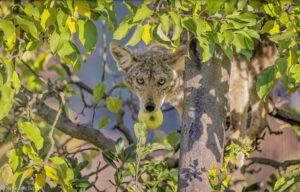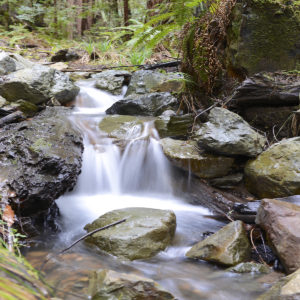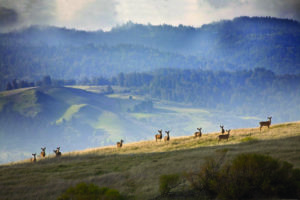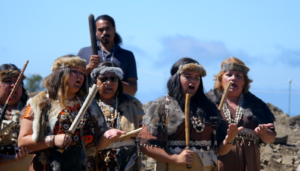Midpen at 50
More pieces in this series exploring the open space district’s history and work.• Caring for the Land That Cares For Us How Midpen was born from a grassroots campaign.
• The Revival of a Clear Creek With old logging roads transformed, clean water and wildlife return to El Corte de Madera.
• Dancing on the Peak Again The Amah Mutsun hold their first ceremony on Mount Umunhum in two centuries.
• Coexistence: Cattle Ranching Meets Sensitive Species When livestock and conservation needs align.
Badgers aren’t the biggest animals around here, but pound for pound, they might just be the baddest. Stocky and strong, with big front claws and a pugnacious attitude, adult badgers have the run of their grassland habitat.
“They have very few natural predators,” Midpen resource specialist Karine Tokatlian tells me, “mainly because they’re so … I don’t know, ornery? I guess you could say they have a lot of personality.”
Tokatlian and Midpen senior resource specialist Julie Andersen are showing me around Long Ridge Open Space Preserve, the southernmost in a cluster of six Midpen preserves along Skyline Boulevard that form the heart of badger country on the peninsula. The area’s rolling meadows are ideal for badgers to dig burrows and hunt for prey like ground squirrels and gophers.
Despite protected spaces like these, badgers are in decline statewide. Scientists attribute this in part to habitat loss and fragmentation—including the risk of being hit by vehicles while attempting to cross traffic.
“Road strikes are one of the largest causes of badger mortality,” Andersen says, speaking over the Doppler-shifted whoosh of a car passing on Skyline Boulevard upslope. “See how fast people drive on this road? If badgers want to get from this patch of grassland to that one over there, they’re dealing with that.”
Of course, badgers aren’t the only animals in the region challenged by road crossings: mountain lions, for example, maintain large territories that often put them in harm’s way. To improve habitat connectivity, Midpen is working with partners to supplement a dark, narrow culvert under Highway 17 near Lexington Reservoir with another underpass designed specifically for wildlife. This spring, the Land Trust of Santa Cruz County broke ground on similar upgrades farther south. Once both projects are complete, Andersen says, “we’ll have taken care of the two most deadly spots for mountain lions on all of Highway 17”—and linked more than 30,000 acres of protected habitat.
Cars currently kill one or two of the big cats on Highway 17 each year. That might not sound like a lot, but with genetic studies suggesting that the local cougar population is on the cusp of critical fragmentation, the consequences are far-reaching. “If we can get even one or two more across the highway, that could represent enough genetic variety to sustain the population,” Andersen says.
But what about the badgers? Until recently, Tokatlian says, the effect of fragmentation on these animals wasn’t well understood. “We knew badgers were present, and we had a general idea of their habitat needs—but we didn’t really know anything about the peninsula’s population beyond that.”
To learn how Midpen can support badgers, Midpen researchers spent years studying the animals’ movements and behavior. Since 2019, they’ve walked dozens of kilometer-long transects, searching for burrows. They collected tufts of badger fur for DNA analysis to determine the population’s family ties. And they set up motion-activated cameras, combing through footage for insights.
Now, Tokatlian and her team are getting ready to publish their study. Some of the findings, she says, are “sobering.”
The researchers found that badgers have “one narrow path along the east side of the Peninsula, one along the coast, and one core central area that allows them to travel,” Tokatlian says. Everything else, from the steep, forested ravines that act as natural badger blockers to the cities of Silicon Valley—which for the past century have expanded across onetime grasslands—“is unsuitable, or at least very challenging for them.”

If not for places like Long Ridge, the outlook for badgers might be worse. But while the study validates the importance of the preserves, Andersen says, it also highlights the need to create connections between them. The DNA samples indicate that Peninsula badgers are more inbred than populations elsewhere in California. “If you’re a badger here in the middle and you can’t travel to meet badgers far to the east or to the west, you can’t avoid interbreeding,” Tokatlian explains.
Midpen will draw on the findings to help prioritize future land acquisitions and guide management decisions, such as identifying where it’s most important to restore grassland habitat. And by mapping road strikes against badger habitat, experts can pinpoint where undercrossings or culverts along busy roadways could do the most to help badgers—and other wildlife—get where they need to go.
“With the badger study, we focused on the habitat qualities that badgers require,” Andersen says. “But providing that connectivity will benefit a lot of other species, too.”

Midpeninsula Regional Open Space District is a public agency whose mission is to acquire and preserve a regional greenbelt of open space land in perpetuity, protect and restore the natural environment, and provide opportunities for ecologically sensitive public enjoyment and education.
On the San Mateo County coast, Midpen’s mission also includes acquiring and preserving in perpetuity open space land and agricultural land of regional significance, preserving rural character, and encouraging viable agricultural use of land resources. OpenSpace.org





